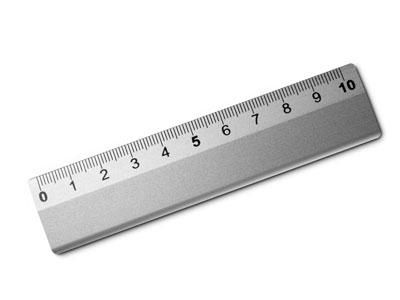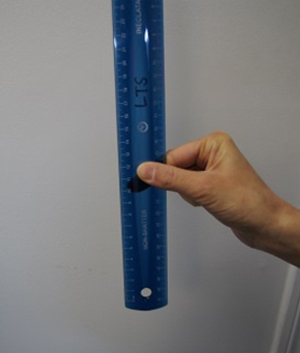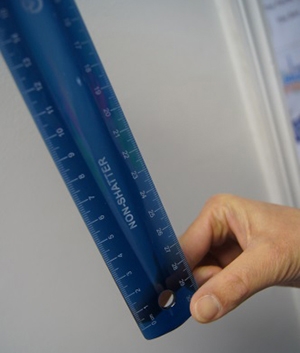How fast can you react?
How does this align with my curriculum?
What is a reflex? Test your reaction time and find out why reflexes are important in this challenge activity.
What You Need
- Ruler (metre stick)
- 2 people
- Paper and pencil
What To Do
- Person 1 holds the ruler vertically at the top end between their thumb and index finger. The ruler should be held away from the body and around eye level for person 2.
- The person who wishes to test their reflexes (person 2) puts their thumb and index finger on either side of the ruler at the bottom end by the 0 mark (but not touching it).
- Person 1 drops the ruler without warning.
- Person 2 tries to catch the ruler as soon as they realise it is falling.
- Write down at what mark on the ruler person 2 caught it (cm).
- Repeat at least 3 times and get the average of the three measurements where the ruler was caught.
- The distance the ruler falls before being caught is a measure of their reflexes. Check the chart to see how fast you reacted!
| Distance (cm) | Time (milliseconds) | Distance (cm) | Time (milliseconds) |
|---|---|---|---|
| 1 | 45 | 21 | 207 |
| 2 | 64 | 22 | 212 |
| 3 | 78 | 23 | 217 |
| 4 | 90 | 24 | 221 |
| 5 | 101 | 25 | 226 |
| 6 | 111 | 26 | 230 |
| 7 | 120 | 27 | 235 |
| 8 | 128 | 28 | 239 |
| 9 | 136 | 29 | 243 |
| 10 | 143 | 30 | 247 |
| 11 | 150 | 31 | 252 |
| 12 | 156 | 32 | 256 |
| 13 | 163 | 33 | 260 |
| 14 | 169 | 34 | 263 |
| 15 | 175 | 35 | 267 |
| 16 | 181 | 36 | 271 |
| 17 | 186 | 37 | 275 |
| 18 | 192 | 38 | 278 |
| 19 | 197 | 39 | 282 |
| 20 | 202 | 40 | 286 |
Discovery
Reaction time is a measure of how quickly an organism responds to some sort of stimulus – a change in the environment that an organism reacts to. You also have "reflexes" too. Reflexes and reactions may seem similar but they are actually quite different. A Reflex is an involuntary response that the body uses to protect itself. A reflex is faster than a reaction. The classic example of a reflex test is one you may have experienced at your doctor's office, when the doctor hits you with a small rubber mallet just below the knee. This called the patellar reflex.
The nervous system helps information travel through your body. It consists of your five senses, your brain, your spinal column, and the nerves that connect them all together. Suppose your eyes see a baseball flying toward your head. They send a message about the approaching ball to your brain. This message travels to a part of your brain called the cerebrum through your nerves. Your cerebrum sends this information to the cerebellum, which has to choose what you are going to do about the ball. It finally decides that you should catch it—after all, you’re wearing your baseball glove! The cerebellum sends this decision as message through other nerves to the arm and hand, activating the muscles used to catch the ball. Of course, all this takes time!
The time it takes from when your eye first notices the ball to when your arm reaches up to catch the ball is an example of reaction time. Even though stimuli travel very quickly along your nervous system as messages, your body doesn’t react instantly. Many athletes spend hours practicing to improve their reaction time.
This experiment tested reaction time and voluntary movement. However, there are reactions known as simple reflexes that are involuntary movements produced by the body in response to certain stimuli. Some of these reflexes are simple things like blinking. Other reflexes can be more complicated such as the withdrawal reflex. An example of the withdrawal reflex is when someone touches something hot and immediately pulls their hand away. Reflexes can prevent serious injury. Reaction time and reflexes can be very important to athletes, especially goalies trying to block pucks and baseball players trying to hit balls. Some sports rely more on reflexes than others, and different sports rely on different reflexes.
- Try the ruler drop test multiple times – can you improve your reaction time?
- Test with multiple people to see if you can find a correlation between reaction time and other factors (examples: height, age, interest in sports, etc.)
For more information on this topic check out these Let's Talk Science resources:
- Neurons: The Building Blocks of Your Brain (Backgrounders) - How does your brain allow you to do and experience so much? It’s all because of the building blocks of your brain - neurons!
What’s happening?
Reaction time is a measure of how quickly an organism responds to some sort of stimulus – a change in the environment that an organism reacts to. You also have "reflexes" too. Reflexes and reactions may seem similar but they are actually quite different. A Reflex is an involuntary response that the body uses to protect itself. A reflex is faster than a reaction. The classic example of a reflex test is one you may have experienced at your doctor's office, when the doctor hits you with a small rubber mallet just below the knee. This called the patellar reflex.
The nervous system helps information travel through your body. It consists of your five senses, your brain, your spinal column, and the nerves that connect them all together. Suppose your eyes see a baseball flying toward your head. They send a message about the approaching ball to your brain. This message travels to a part of your brain called the cerebrum through your nerves. Your cerebrum sends this information to the cerebellum, which has to choose what you are going to do about the ball. It finally decides that you should catch it—after all, you’re wearing your baseball glove! The cerebellum sends this decision as message through other nerves to the arm and hand, activating the muscles used to catch the ball. Of course, all this takes time!
The time it takes from when your eye first notices the ball to when your arm reaches up to catch the ball is an example of reaction time. Even though stimuli travel very quickly along your nervous system as messages, your body doesn’t react instantly. Many athletes spend hours practicing to improve their reaction time.
Why does it matter?
This experiment tested reaction time and voluntary movement. However, there are reactions known as simple reflexes that are involuntary movements produced by the body in response to certain stimuli. Some of these reflexes are simple things like blinking. Other reflexes can be more complicated such as the withdrawal reflex. An example of the withdrawal reflex is when someone touches something hot and immediately pulls their hand away. Reflexes can prevent serious injury. Reaction time and reflexes can be very important to athletes, especially goalies trying to block pucks and baseball players trying to hit balls. Some sports rely more on reflexes than others, and different sports rely on different reflexes.
Investigate further
- Try the ruler drop test multiple times – can you improve your reaction time?
- Test with multiple people to see if you can find a correlation between reaction time and other factors (examples: height, age, interest in sports, etc.)
For more information on this topic check out these Let's Talk Science resources:
- Neurons: The Building Blocks of Your Brain (Backgrounders) - How does your brain allow you to do and experience so much? It’s all because of the building blocks of your brain - neurons!


